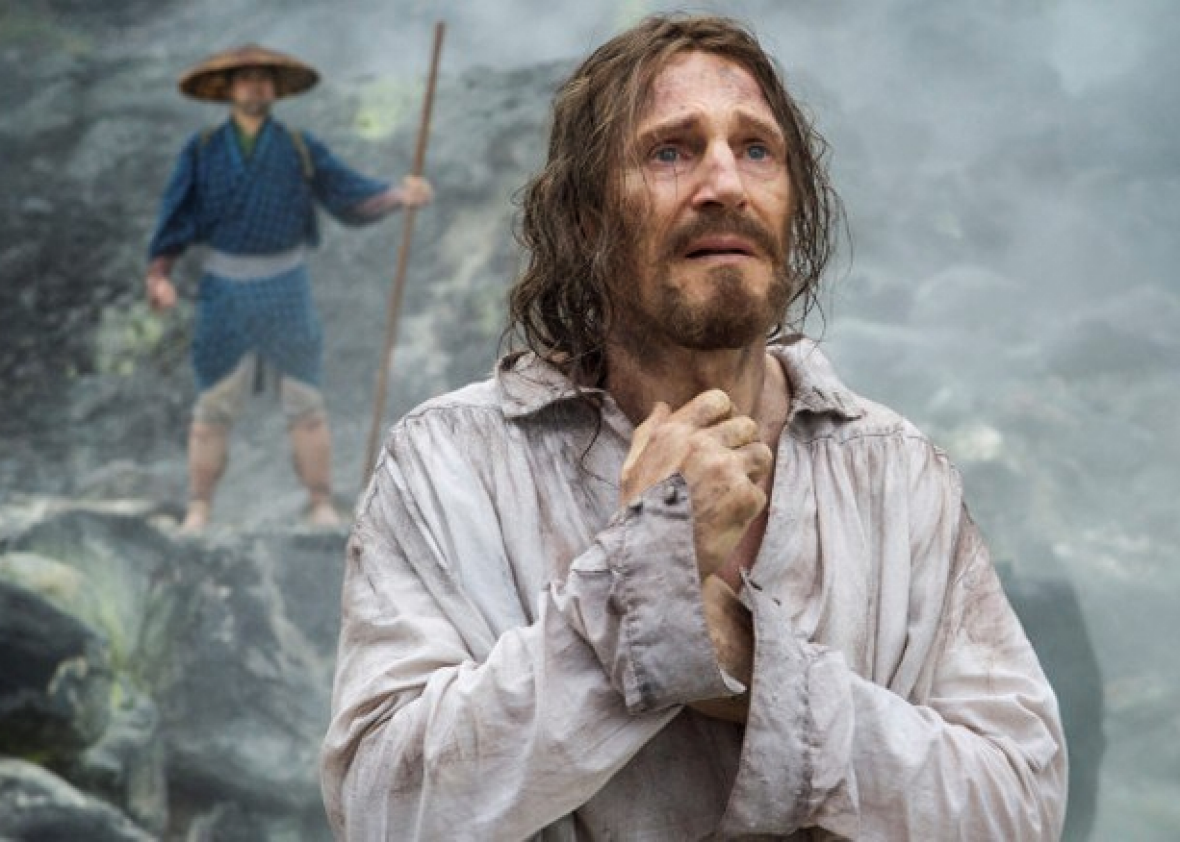Amid the din of the hot movie releases of late December—Awards hopefuls! Box-office blockbusters! Franchise spinoffs!—Martin Scorsese’s Silence seems to arrive from another moviegoing universe entirely. This two-hour-and-40-minute–long adaptation of a 1966 novel by the Japanese Catholic convert Shusaku Endo, a movie Scorsese has wanted to make for nearly 30 years, moves at a stately, somber pace, unbothered by the earthly demands of typical Hollywood pacing or plot. Though it contains many scenes of prolonged suffering and a few shocking moments of graphic violence, Silence bears a contemplative stillness at its heart.
The spiritual questions asked, often in voiceover, by the young priest at the film’s center—a 17th-century Portuguese Jesuit missionary named Sebastian Rodrigues (a stunning Andrew Garfield)—are clearly still of vital importance to the 74-year-old filmmaker, who grew up in a devoutly Catholic family and has long built his movies, even the gangster epics, around struggles between faith and doubt. If there is a loving God, why is the world filled with so much cruelty and suffering? Is there any proper way to draw the line between what our fellow humans require of us and what we’re able to give without betraying our own beliefs? And even if it’s true that all our prayers vanish forever into a godless silence, is it not possible that the act of praying is still worth it?
Sebastian’s voiceover begins the film as the text of a letter he’s writing from Japan to the senior Portuguese priest (Ciarán Hinds) who has sent him there with another young Jesuit, Francisco Garrpe (Adam Driver), to find out what happened to another missionary (Liam Neeson) who disappeared in Japan years before, reportedly after publicly renouncing his faith and marrying a Japanese woman. Stopping off in Macau en route to Japan, the travelers hire a Japanese translator, Kichijiro (Yosuke Kubozuka), to accompany them. Kichijiro proves to be an unreliable, possibly perfidious drunkard—but also a fervent and repentant Catholic who appeals again and again for forgiveness from the “padres” he’s tempted to betray to the anti-Christian authorities. Instead, he leads the priests to a secretly Christian seaside village, where they can be hidden from sight during raids by the local inquisitor. In one of the film’s most indelible sequences, as sublimely shot (by cinematographer Rodrigo Prieto) as it is emotionally gutting, the two young men huddle for warmth in a seaside cave, watching in horror as three of the most devout villagers are subjected to crucifixion by water, tied to crosses left to stand on the narrow beach as a violent tide rolls in.
For their safety, the two priests agree to separate for a time; their brief but impassioned goodbye makes for another wrenching scene, a reminder that in this hostile foreign land the only thing these two frightened men have is each other and their faith. For the last two-thirds of the film we mainly follow the wanderings of Garfield’s Father Rodrigues, who grows ever gaunter, more ragged, and more spiritually bereft. He’s eventually taken prisoner by a sadistic inquisitor (marvelously played by Issey Ogata), who enjoys toying with the priest’s deeply held faith by staging surprise acts of violence on other Christian holdouts directly in front of Sebastian’s cagelike hut.
The priest must, of course, make a choice about whether and under what circumstances to deny his faith. That long-built-toward climax fully earns its tone of operatic intensity. Scorsese, a filmmaker known for using pop music and montage to whip audiences into a visual and auditory frenzy, here uses stillness and silence—an immobile camera and a sound mix in which nothing, not even the movement of air or the soft crunch of feet in dust, can be heard—to superb effect.
Despite its technical and visual grandeur, there’s a moral simplicity to Silence that can sometimes recall the work of perhaps the other greatest deeply Catholic filmmaker, the French master Robert Bresson. Though it takes place hundreds of years in the past during the clash between two profoundly different cultures, this movie’s story feels contemporary without having to strain for explicit modern parallels. Silence is about the struggle to reconcile long-held ideals with everyday moral behavior; about the threat of violence that’s always present when deep-held belief systems, especially religious ones, come into conflict; and about the lasting damage inflicted by a global colonialist system that was just gearing up in the 1640s but that persists in many guises today.
Scorsese’s multidecade fight to get Silence made reads like a pilgrim’s progress in itself. Sometimes the dream projects that venerable creators finally get to realize after years of struggle can have a feeling of closed-off interiority, as if the filmmaker were exploring his or her deepest wishes and fears at the expense of the audience’s understanding—or patience. Silence is just the reverse. Religious believer or no, if you can slow down enough to enter into the very different place and time this movie posits—a world in which the freedom to pursue one’s chosen faith was the measure of human freedom itself—Silence opens up a space for communal contemplation, like stepping into the dark but soaring nave of a cinematic cathedral.
Read more of Slate’s coverage of the Oscar race.
